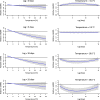The association between ambient temperature and mortality of the coronavirus disease 2019 (COVID-19) in Wuhan, China: a time-series analysis
- PMID: 33430851
- PMCID: PMC7797893
- DOI: 10.1186/s12889-020-10131-7
The association between ambient temperature and mortality of the coronavirus disease 2019 (COVID-19) in Wuhan, China: a time-series analysis
Abstract
Background: The COVID-19 has caused a sizeable global outbreak and has been declared as a public health emergency of international concern. Sufficient evidence shows that temperature has an essential link with respiratory infectious diseases. The objectives of this study were to describe the exposure-response relationship between ambient temperature, including extreme temperatures, and mortality of COVID-19.
Methods: The Poisson distributed lag non-linear model (DLNM) was constructed to evaluate the non-linear delayed effects of ambient temperature on death, by using the daily new death of COVID-19 and ambient temperature data from January 10 to March 31, 2020, in Wuhan, China.
Results: During the period mentioned above, the average daily number of COVID-19 deaths was approximately 45.2. Poisson distributed lag non-linear model showed that there was a non-linear relationship (U-shape) between the effect of ambient temperature and mortality. With confounding factors controlled, the daily cumulative relative death risk decreased by 12.3% (95% CI [3.4, 20.4%]) for every 1.0 °C increase in temperature. Moreover, the delayed effects of the low temperature are acute and short-term, with the most considerable risk occurring in 5-7 days of exposure. The delayed effects of the high temperature appeared quickly, then decrease rapidly, and increased sharply 15 days of exposure, mainly manifested as acute and long-term effects. Sensitivity analysis results demonstrated that the results were robust.
Conclusions: The relationship between ambient temperature and COVID-19 mortality was non-linear. There was a negative correlation between the cumulative relative risk of death and temperature. Additionally, exposure to high and low temperatures had divergent impacts on mortality.
Keywords: Ambient temperature; COVID-19; Distributed lag non-linear model; Mortality; Negative correlation.
Conflict of interest statement
The author declares that he has no competing interests.
Figures





Similar articles
-
The Short-Term Effect of Ambient Temperature on Mortality in Wuhan, China: A Time-Series Study Using a Distributed Lag Non-Linear Model.Int J Environ Res Public Health. 2016 Jul 18;13(7):722. doi: 10.3390/ijerph13070722. Int J Environ Res Public Health. 2016. PMID: 27438847 Free PMC article.
-
Part 2. Association of daily mortality with ambient air pollution, and effect modification by extremely high temperature in Wuhan, China.Res Rep Health Eff Inst. 2010 Nov;(154):91-217. Res Rep Health Eff Inst. 2010. PMID: 21446212
-
The correlation between temperature and the incidence of COVID-19 in four first-tier cities of China: a time series study.Environ Sci Pollut Res Int. 2022 Jun;29(27):41534-41543. doi: 10.1007/s11356-021-18382-6. Epub 2022 Jan 30. Environ Sci Pollut Res Int. 2022. PMID: 35094276 Free PMC article.
-
[Acute impact of cold spells on mortality during 2001-2011 in Jiang'an district of Wuhan, China].Zhonghua Yu Fang Yi Xue Za Zhi. 2016 Jul 6;50(7):634-9. doi: 10.3760/cma.j.issn.0253-9624.2016.07.014. Zhonghua Yu Fang Yi Xue Za Zhi. 2016. PMID: 27412842 Chinese.
-
Effects of ambient temperature on hospital admissions for obstructive nephropathy in Wuhan, China: A time-series analysis.Ecotoxicol Environ Saf. 2022 Sep 1;242:113876. doi: 10.1016/j.ecoenv.2022.113876. Epub 2022 Jul 13. Ecotoxicol Environ Saf. 2022. PMID: 35841652
Cited by
-
COVID-19 mortality and exposure to airborne PM2.5: A lag time correlation.Sci Total Environ. 2022 Feb 1;806(Pt 3):151286. doi: 10.1016/j.scitotenv.2021.151286. Epub 2021 Oct 29. Sci Total Environ. 2022. PMID: 34743816 Free PMC article.
-
Relationship between meteorological factors and mortality in patients with coronavirus disease 2019: A cross-sectional study.Heliyon. 2023 Jul 22;9(8):e18565. doi: 10.1016/j.heliyon.2023.e18565. eCollection 2023 Aug. Heliyon. 2023. PMID: 37576230 Free PMC article.
-
Associations of ambient temperature and relative humidity with hospital admissions in macau, China using time series analysis.Sci Rep. 2025 Jul 17;15(1):25968. doi: 10.1038/s41598-025-11913-y. Sci Rep. 2025. PMID: 40676195 Free PMC article.
-
Climatic influences on cardiovascular diseases.World J Cardiol. 2022 Mar 26;14(3):152-169. doi: 10.4330/wjc.v14.i3.152. World J Cardiol. 2022. PMID: 35432772 Free PMC article. Review.
-
Dynamic modeling and data fitting of climatic and environmental factors and people's behavior factors on hand, foot, and mouth disease (HFMD) in Shanghai, China.Heliyon. 2023 Jul 24;9(8):e18212. doi: 10.1016/j.heliyon.2023.e18212. eCollection 2023 Aug. Heliyon. 2023. PMID: 37576260 Free PMC article.
References
-
- WHO . Update 49—SARS case fatality ratio, incubation period. 2003.
MeSH terms
Grants and funding
LinkOut - more resources
Full Text Sources
Other Literature Sources
Medical

